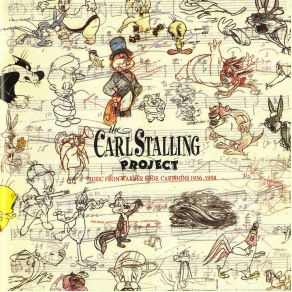The Carl Stalling Project - Music from Warner Bros. Cartoons 1936-1958
Download links and information about The Carl Stalling Project - Music from Warner Bros. Cartoons 1936-1958 by Carl Stalling. This album was released in 1990 and it belongs to Theatre/Soundtrack genres. It contains 11 tracks with total duration of 59:23 minutes.

|
|
|---|---|
| Artist: | Carl Stalling |
| Release date: | 1990 |
| Genre: | Theatre/Soundtrack |
| Tracks: | 11 |
| Duration: | 59:23 |
| Buy it NOW at: | |
| Buy on iTunes $7.59 | |
Tracks
[Edit]| No. | Title | Length |
|---|---|---|
| 1. | Putty Tat Trouble Part 6 (1951) | 1:20 |
| 2. | Hillbilly Hare (1950) | 4:22 |
| 3. | Early WB Scores: The Depression Era (1936-1941) | 6:02 |
| 4. | There They Go Go Go (1956) | 5:24 |
| 5. | Stalling Self-Parody: Music from Porky's Preview (1941) | 5:25 |
| 6. | Anxiety Montage (1952-1955) | 6:11 |
| 7. | Carl Stalling With Milt Franklyn In Session | 7:14 |
| 8. | Speedy Gonzalez (1955) Meets Two Tacos [1956] | 5:33 |
| 9. | Powerhouse and Other Cuts from the Early 50's | 6:15 |
| 10. | Porky In Wackyland (1938) / Dough for the Do Do [1949] | 5:43 |
| 11. | To Itch His Own (1958) | 5:54 |
Details
[Edit]The first volume in The Carl Stalling Project series is a revelation; more than just an essential part of a Warner Bros. staff that generated some of the finest and most inspired productions in the history of animation, Stalling was a visionary whose work deserves consideration among the finest American avant-garde music ever recorded. As these 15 selections from WB cartoons dating between 1936 and 1958 attest, his cut and paste style — a singular collision between jazz, classical, pop, and virtually everything else in between — was unprecedented in its utter disregard for notions of time, rhythm, and compositional development; Stalling didn't just break the rules, he made them irrelevant. That in the process he created music beloved by succeeding generations of children is more impressive still — perhaps even unwittingly, Stalling introduced the avant-garde into the mainstream, and as popular music continues to diversify and hybridize, his stature as a pioneer rightfully continues to grow.